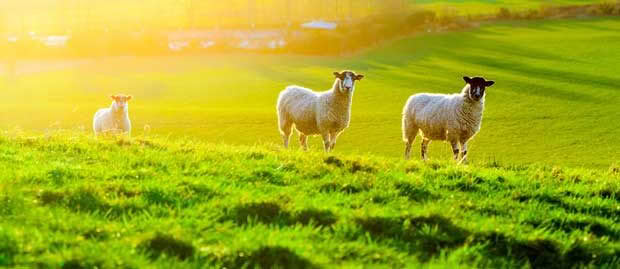How to care for sheep this autumn

It’s the start of a new sheep year and the breeding season, so start with tidying up the ewe flock before the rams go out.
Words: Clive Dalton
The main decisions are what to get rid of. Here are some suggestions:
– All ewes that didn’t produce a lamb at birth (Dry/Dry) or that produced a lamb but didn’t rear it (Wet/Dry). The chances are high that they’ll do this again unless the lamb deaths were accidents.
– All ewes with persistent foot rot – it’s inherited and they are a permanent source of infection on the farm.
– Ewes that don’t have good even teeth that meet the gum correctly. Note, teeth in young sheep may not have erupted yet or may still be coming through. Don’t keep old ewes with long loose teeth and gaps between them. If teeth are very short and even, they’ll last another year.
– Check that each half of the udder is even, and that there are no hard lumps or damaged teats. Shearing is a good time for this.
– Cull any ewes that have been continually daggy during the season when their mates have remained clean. Persistent dags are an inherited trait.
– Sell store lambs (wethers and cull ewe lambs) that you don’t have room to winter.
– The shorter daylight pattern will stimulate ewes to start cycling, and also stimulate the rams. The ewes are stimulated by the ram’s pheromones in their wool grease so the stronger the ram/s smell, the more they’ll get ewes to ovulate.
– The key to a successful mating season is to have both ewes and rams in top body condition at joining. If you can, keep the ewes isolated from the sight and smell of the rams before joining – this will cause better synchrony when they get together and will help to concentrate lambing so you avoid a lot of tail-end lambs at weaning.
– Using a ram mating harness will show which ewes have been mated and have not returned. Make sure the harness fits well, and check it daily for chafing. An active ram will lose weight fast and the harness will need regular adjustments.
– Ewes cycle on average every 17 days (range 14-21) once they have started cycling. At first joining there is a period of ‘silent heats’ when the ewes ovulate but don’t show outward signs of heat and let the ram mate.
– If using one ram at a time, change him over after the first cycle (17 days) in case he has low fertility. If he was vet checked before mating he should be sound, but you never know. His libido may not guarantee his fertility.
– If you turn out more than one ram with a mating group, make sure they don’t spend all their time fighting, or if one dominant ram doesn’t prevent the others working.
– Don’t treat ewes or rams with dip or pour-ons for at least a month before mating and for six weeks after mating, as this may affect embryo survival. It’s better to be safe.
– If ewe hoggets are big enough (minimum 45kg) and you want extra lambs then join them with the ram, but they will need extra feed right up to the two-tooth stage as they are still growing.
– Mature sheep should not need drenching as their immunity is fully developed, but if any young sheep start to scour, don’t drench them before a vet has checked the cause (using Faecal Egg Counts) and recommended the appropriate treatment. It may not be worms.
– Facial eczema is still a risk for many parts of NZ at this time of year so maintain prevention right into April. Consult your vet for prevention methods.
AUTUMN SHEEP TIPS
• Tidy up the ewe flock and get rid of all stock that won’t earn their keep next season, any that have had chronic health problems during the year.
• Make sure rams are in good health (and vet checked) before joining, and make sure they are working properly.
• Plan mating to get all lambs off the place before next Christmas holidays, so restrict the mating season to two cycles with the main sires.
• You don’t want ewes lambing late next season with small late lambs – they never catch up and never make money.
• Keep a regular watch on rams joined with ewes to make sure they are working properly. If in doubt, change them regularly.
• Check with your shearer when to shear. The only market is for wool 100mm long, which means shearing twice a year.
• Shearing both ewes and rams a month before joining is the best option. Don’t shear during joining. Whenever you shear, watch out for a cold snap and have good feed and shelter available for newly-shorn ewes.
• Be wary of adverts encouraging you to drench ewes and lambs – check with your veterinarian about their cost/benefits first.
• If you have to euthanise a sheep, make sure to use a method which complies with the Animal Welfare Act 1999.
Love this story? Subscribe now!
 This article first appeared in NZ Lifestyle Block Magazine.
This article first appeared in NZ Lifestyle Block Magazine.
